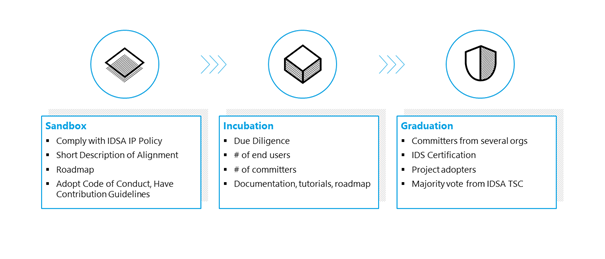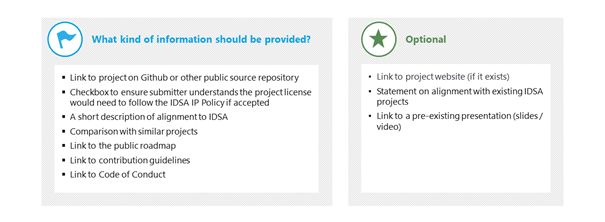IDSA has been working for some time on providing a catalog of our open-source projects. This is where everyone who is interested in experimenting with data spaces can choose their ingredients (building blocks) and check the recipes (deployment scenarios/examples) they can use to implement a working data space. Owners of IDS-related projects are therefore warmly invited to apply to become an official IDSA open-source project (IDS Open Source Sandbox Application – International Data Spaces).
The role of the IDS open-source graduation scheme
Not only does IDSA’s open-source graduation scheme provide a set of rules and processes, it outlines the extent to which implementations of IDS components have matured. Furthermore, the graduation scheme will support implementers by offering them a curated list of projects to choose from. This is expected to quicken the development of data spaces and their future implementation.
What are the levels of the Graduation Scheme?
The graduation scheme consists of three consecutive levels: sandbox, incubation, graduation. Each has different requirements which projects need to fulfill before they move on to the next level.

What are the benefits of applying to the IDS open-source graduation scheme?
Being an official IDS open-source solution gives your project several advantages. Firstly, it gives you a chance to get closer to the community, other experimenters, and initiatives also dealing with data spaces. It’s how you can find your voice in the wider discussion. Secondly, this transparent and collaborative environment gives you a chance to gather feedback on your product. As data space projects are still taking their first steps, these contributions are the most valuable asset a product can have. After all, what doesn’t kill a product, only makes it stronger! Last but not least, being an official IDS open source solution will boost your project’s visibility among the renowned institutions that are part of the IDSA network.
How can I apply to become a Sandbox project?
The first step on the IDS open-source graduation scheme is applying to become a sandbox project. You can do this by using the form available on the IDSA website (IDS Open Source Sandbox Application – International Data Spaces). As with the other levels on the graduation scheme, there are certain requirements your project needs to meet.

What happens after the application?
Simple: Your application gets evaluated by IDSA’s technical steering committee, who’ll give you an answer within a few weeks. All being well, your application then gets published on the IDSA Github page, and your project finds its place on the IDS open-source map. Your project’s incubation begins.
Which projects are already on the map?
As of February 2022, Eclipse Dataspace Connector and TRUE Connector are the first certified sandbox projects of the IDS open-source graduation scheme. We invite all other projects, whether already part of IDSA GitHub or not, to apply and take their well-deserved place in the catalog of IDS open-source projects.
Read more about the top concerns and top reasons to use open-source software here.




